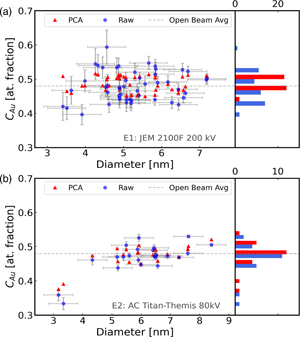Article contents
Improving Quantitative EDS Chemical Analysis of Alloy Nanoparticles by PCA Denoising: Part II. Uncertainty Intervals
Published online by Cambridge University Press: 18 April 2022
Abstract

Analytical studies of nanoparticles (NPs) are frequently based on huge datasets derived from hyperspectral images acquired using scanning transmission electron microscopy. These large datasets require machine learning computational tools to reduce dimensionality and extract relevant information. Principal component analysis (PCA) is a commonly used procedure to reconstruct information and generate a denoised dataset; however, several open questions remain regarding the accuracy and precision of reconstructions. Here, we use experiments and simulations to test the effect of PCA processing on data obtained from AuAg alloy NPs a few nanometers wide with different compositions. This study aims to address the reliability of chemical quantification after PCA processing. Our results show that the PCA treatment mitigates the contribution of Poisson noise and leads to better quantification, indicating that denoised results may be reliable from the point of view of both uncertainty and accuracy for properly planned experiments. However, the initial data need to be of sufficient quality: these results can only be obtained if the signal-to-noise ratio of input data exceeds a minimal value to avoid the occurrence of random noise bias in the PCA reconstructions.
Keywords
- Type
- Software and Instrumentation
- Information
- Copyright
- Copyright © The Author(s), 2022. Published by Cambridge University Press on behalf of the Microscopy Society of America
References
- 3
- Cited by




